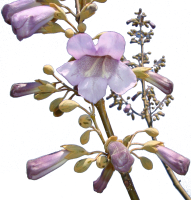History of Paulownia
Paulownia wood has been used in Japan for centuries primarily as a furniture wood. Wooden chests of drawers called Tansu are made from this wood and nearly every Japanese home has a Tansu of solid Paulownia, or sliced Paulownia veneer glued on a Lauan plywood. Other uses of the wood include musical instruments called Koto, wooden clogs called Geta, ornamental carvings, wooden bowls and spoons, bas relief panels, and large and small gift boxes. While the Japanese do not consider this tree "Holy", the wood is held in reverence by those who work with the tree, possibly due to the ability of the tree to regenerate from its own root. This, coupled with its resistance to rot and its freedom from checking and cracking, may account for this reverence.
Properties of Paulownia
Paulownia is 30% lighter than any comparable American hardwood, falling mid-way between balsa and poplar. The wood weighs between 15 and 19 pounds per cubic foot air dried. The tree will not rot when felled in the forest unless it is touching a contaminant of some sort. The lumber can be air dried in as little as 60 days in racks or kiln dried to 10% - 12% moisture in five to seven days.
Uses
Logs may be debarked, milled into lumber, and exported, or used in established domestic markets. U.S.-based markets are being developed continuously and account for over 80% of all timber harvested domestically. Water and snow sport products make up much of the current usage, and marine grade plywood production efforts are well underway.
2025 Membership is Now Open
Benefits of Membership
Benefits of Membership
Join the Association to receive discounts on conference registrations, training classes and items available for purchase from the Association. Corporate-level members may also advertise on our site (an additional fee applies). Members also have access to the members-only photo gallery on our site.
Help Grow the Market for Paulownia
The Association has no salaried employees. Your dues income goes toward helping the Association to promote awareness of the Paulownia tree and to help grow the market for the use of Paulownia.


